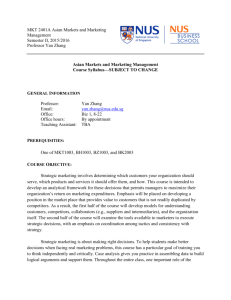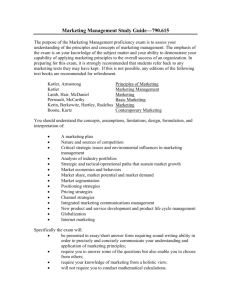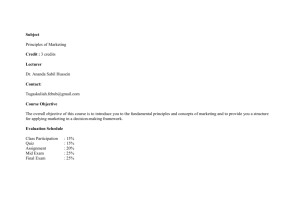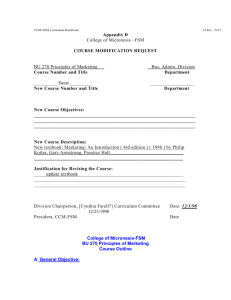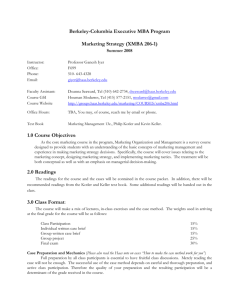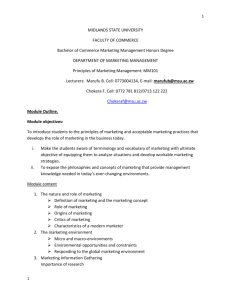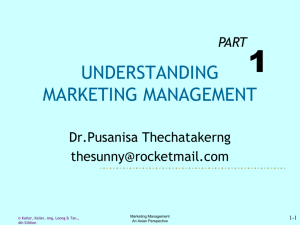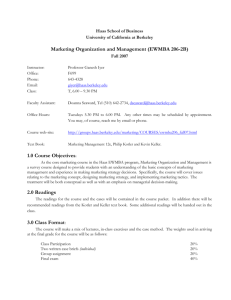8 IDENTIFYING 4/8/2011
advertisement
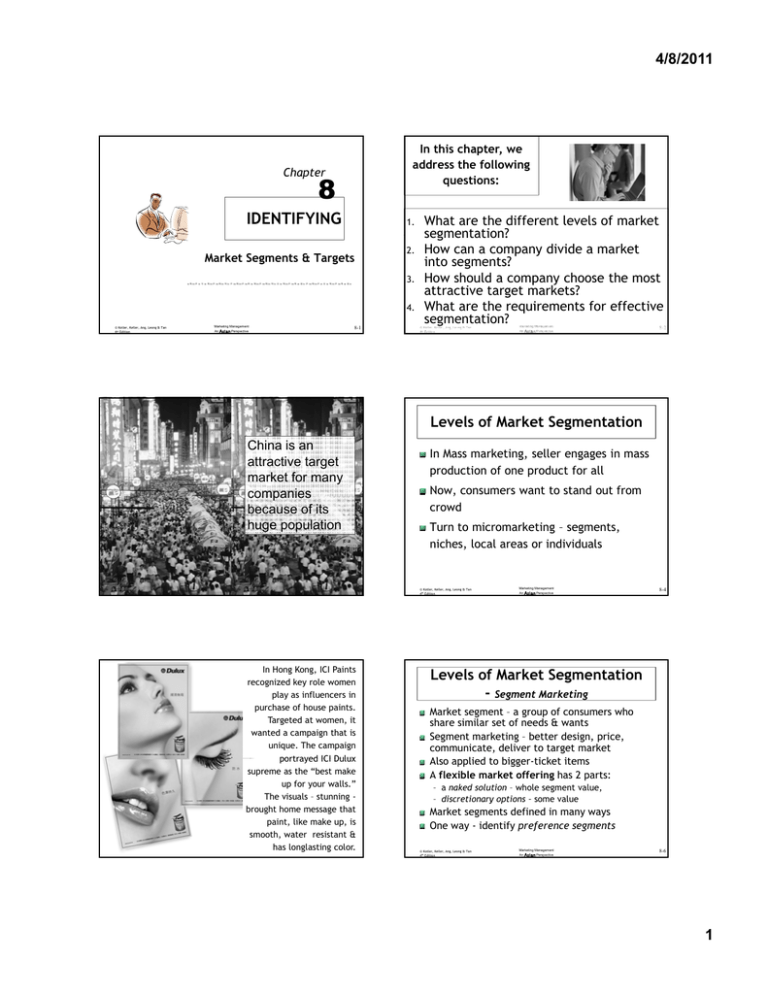
4/8/2011 In this chapter, we address the following questions: Chapter 8 IDENTIFYING 1. Market Segments & Targets 2. 3. 4. © Kotler, Keller, Ang, Leong & Tan 4th Edition Marketing Management An Asian Perspective 8-1 What are the different levels of market segmentation? How can a company divide a market into segments? How should a company choose the most attractive target markets? What are the requirements for effective segmentation? © Kotler, Keller, Ang, Leong & Tan 4th Edition Marketing Management An Asian Perspective 8-2 Levels of Market Segmentation China is an attractive target market for many companies because of its huge population © Kotler, Keller, Ang, Leong & Tan 4th Edition © Kotler, Keller, Ang, Leong & Tan 4th Edition Marketing Management An Asian Perspective In Mass marketing, seller engages in mass production of one product for all Now, consumers want to stand out from crowd Turn to micromarketing – segments, niches, local areas or individuals 8-3 In Hong Kong, ICI Paints recognized key role women play as influencers in purchase of house paints. Targeted at women, it wanted a campaign that is unique. The campaign portrayed ICI Dulux supreme as the “best make up for your walls.” The visuals – stunning brought home message that paint, like make up, is smooth, water resistant & has longlasting color.8-5 Marketing Management An Asian Perspective © Kotler, Keller, Ang, Leong & Tan 4th Edition Marketing Management An Asian Perspective 8-4 Levels of Market Segmentation - Segment Marketing Market segment – a group of consumers who share similar set of needs & wants Segment marketing – better design, price, communicate, deliver to target market Al applied Also li d tto bi bigger-ticket ti k t it items A flexible market offering has 2 parts: – a naked solution – whole segment value, – discretionary options – some value Market segments defined in many ways One way - identify preference segments © Kotler, Keller, Ang, Leong & Tan 4th Edition Marketing Management An Asian Perspective 8-6 1 4/8/2011 Figure 8.1 Basic Market-Preference Patterns Although Vietnam is becoming more modernized, selling products by using traditional baskets balanced over one’s shoulder is still a common feature ice cream attributes -sweetness & creaminess Homogeneous preferences – Figure 8.1(a) - all consumers roughly same preferences - no segments Diffused preferences – Figure 8.1(b) - consumers vary greatly in their preferences Clustered preferences – reveal distinct preference clusters, called natural market segments Figure 8.1(c) © Kotler, Keller, Ang, Leong & Tan 4th Edition Marketing Management An Asian Perspective 8-7 © Kotler, Keller, Ang, Leong & Tan 4th Edition Marketing Management An Asian Perspective Levels of Market Segmentation - Niche Marketing Levels of Market Segmentation - Niche Marketing A niche - narrowly defined customer group - mix of benefits. An attractive niche: Niche marketers understand customers’ needs that they willingly pay a premium for products – – – – – di ti t sett off needs distinct d will pay a premium for it niche do not attract competitors niche gains economies through specialization niche has size, profit & growth potential © Kotler, Keller, Ang, Leong & Tan 4th Edition Marketing Management An Asian Perspective Globalization has facilitated niche marketing Global niche players tend to be found in stable markets, typically family-owned & are long-lived 8-9 © Kotler, Keller, Ang, Leong & Tan 4th Edition Marketing Management An Asian Perspective Levels of Market Segmentation - Niche Marketing Levels of Market Segmentation - Local Marketing Eg : Ostrichesonline.com – Webpreneur Steve Warrington earns a 6-figure income – sell ostriches & every product derived from them online – Since 1996, > 20,000 clients - >125 countries >17,500 ostrich-related products such as ostrich meat, feathers, videos, eggshells & leather jackets Target marketing is leading to marketing programs tailored to needs & wants of local customer groups Local marketing important in countries with strong regional differences Reflects trend- grassroots marketing - get as close & personally relevant to individual customers as possible © Kotler, Keller, Ang, Leong & Tan 4th Edition Marketing Management An Asian Perspective 8-8 8-11 © Kotler, Keller, Ang, Leong & Tan 4th Edition Marketing Management An Asian Perspective 8-10 8-12 2 4/8/2011 Experiential Marketing Marketers can provide experiences for customers through a set of experience providers: Customer Experience Management (CEM) process of strategically managing a customer’s entire experience with a product or company The CEM framework is made up of 5 basic steps Communications Visual/verbal identity Product presence Co-branding Environments Web sites & electronic media People © Kotler, Keller, Ang, Leong & Tan 4th Edition Marketing Management An Asian Perspective Experiential Marketing Analyze customer’s customer s experiential world Building experiential platform Designing brand experience Structuring customer interface Engaging in continuous innovation 8-13 © Kotler, Keller, Ang, Leong & Tan 4th Edition Marketing Management An Asian Perspective 8-14 Figure 8.2 Examples of Marketing Customization Levels of Market Segmentation - Customerization Ultimate form of segmentation – customization – one-to-one marketing Customerization – operationally driven mass customization & marketing Online firms provide Choiceboard: customer design own products customize its products to each customer on one-to-one basis © Kotler, Keller, Ang, Leong & Tan 4th Edition Marketing Management An Asian Perspective 8-15 © Kotler, Keller, Ang, Leong & Tan 4th Edition Marketing Management An Asian Perspective Segmenting Consumer Markets -Geographic Segmentation Segmenting Consumer Markets -Demographic Segmentation divide market into different geographical units - nations, cities or neighborhoods pay attention to local variations M Mapping i software ft can show h d densestt areas –can resort to customer cloning, assuming that best prospects live where most of customers come from Geoclustering=geographic + demographic data Market divided into groups based on demographic variables – popular –WHY? consumer needs, preferences often associated with demographic variables demographic variables - easy to measure © Kotler, Keller, Ang, Leong & Tan 4th Edition Marketing Management An Asian Perspective 8-17 © Kotler, Keller, Ang, Leong & Tan 4th Edition Marketing Management An Asian Perspective 8-16 8-18 3 4/8/2011 Segmenting Consumer Markets -Demographic Segmentation Segmenting Consumer Markets -Demographic Segmentation Age & Life cycles: Consumer wants & abilities change with age. But, target market for products may be psychologically young Persons in same part of life-cycle may differ in their life stage Life stage - a person’s major concern, such as a divorce divorce, a new home Present opportunities for marketers who can help people cope with their major concerns – Eg Honda tried to target 21-year-olds with Element, described as a ‘dorm room on wheels.” – average age of buyers turned out to be 42! © Kotler, Keller, Ang, Leong & Tan 4th Edition Marketing Management An Asian Perspective 8-19 © Kotler, Keller, Ang, Leong & Tan 4th Edition Marketing Management An Asian Perspective Segmenting Consumer Markets -Demographic Segmentation Segmenting Consumer Markets -Demographic Segmentation Gender - Men & women tend to have different attitudinal & behavioral orientations, based partly on genetic makeup & partly on socialization. Some more male-oriented markets beginning to recognize gender segmentation Income segmentation - automobiles, clothing, cosmetics & travel May not predict best customers for product Firms need to reinvent - huge potential market for those trading up If not – risk being “trapped in the middle” & market share steadily decline – Eg Banks now find women a lucrative segment in Japan © Kotler, Keller, Ang, Leong & Tan 4th Edition Marketing Management An Asian Perspective – Eg General Motors caught in middle of German imports in luxury market & high-value Japanese models in economy class 8-21 © Kotler, Keller, Ang, Leong & Tan 4th Edition Segmenting Consumer Markets -Demographic Segmentation Marketing Management An Asian Perspective Marketing Management An Asian Perspective 8-22 Marketing to Generation Y Growing up times have profound influence on each generation – cohorts share same major cultural, economic experiences - similar outlooks & values Marketers often advertise to a cohort group by using icons & images prominent in their experiences © Kotler, Keller, Ang, Leong & Tan 4th Edition 8-20 Generation Y ≈ 78 million Americans spending power ≈ $187 billion annually 53 yrs life expectancy: $10 trillion range i consumer spending in di turned off by “hard sell” approaches important to marketers – Gen Y is the force that will shape consumer & business markets for years to come 8-23 © Kotler, Keller, Ang, Leong & Tan 4th Edition Marketing Management An Asian Perspective 8-24 4 4/8/2011 Marketing to Generation Y Different approaches to reach Generation Y Online buzz Student ambassadors Unconventional sports Cool events Computer games Videos Street teams © Kotler, Keller, Ang, Leong & Tan 4th Edition Marketing Management An Asian Perspective Segmenting Consumer Markets -Demographic Segmentation Lifestage Analytic Matrix - combines information on cohorts, life stages, physiographics, emotional effects & socio-economics in analyzing a segment/individual 2 individuals from same cohort may differ in their life stages This analysis may lead to more efficient targeting & messages 8-25 © Kotler, Keller, Ang, Leong & Tan 4th Edition Marketing Management 8-26 An Asian Perspective Segmenting Consumer Markets -Demographic Segmentation Segmenting Consumer Markets -Psychographic Segmentation Social class has a strong influence on preference in cars, clothing, leisure activities & retailers Manyy companies p design g p products & services for specific social classes which change with the years 1990s - greed & ostentation for upper classes. Affluent tastes now - more conservative Psychographics - science of using psychology & demographics to better understand consumers In psychographic segmentation, segmentation buyers are divided into different groups on basis of lifestyle/personality/values Same demographic group can exhibit very different psychographic profiles Find out which VALS type you are at SRIC-BI’s Website: www.sric-bi.com © Kotler, Keller, Ang, Leong & Tan 4th Edition Marketing Management An Asian Perspective 8-27 © Kotler, Keller, Ang, Leong & Tan 4th Edition Marketing Management 8-28 An Asian Perspective Figure 8.3 The VALS Segmentation System: An 8- Part Typology Segmenting Consumer Markets -Psychographic Segmentation Innovators upscale, niche-oriented Thinkers durability, functionality A popular classification systems using psychographic measurements SRIC-BI VALSTM classifies adults into 8 primary groups based on personality traits & key demographics Achievers established & prestige Experiencers fashion, entertainment Believers familiar & established Strivers stylish products Makers Find out which VALS type you are at SRIC-BI’s Website: www.sric-bi.com basic, practical Strugglers © Kotler, Keller, Ang, Leong & Tan 4th Edition Marketing Management An Asian Perspective 8-29 © Kotler, Keller, Ang, Leong & Tan 4th Edition Marketing Management An Asian Perspective Loyal to favorite brands 8-30 5 4/8/2011 Segmenting Consumer Markets -Psychographic Segmentation Psychographic segmentation often customized by culture The Japanese VALS 2 key dimensions: life orientation & attitudes to social change © Kotler, Keller, Ang, Leong & Tan 4th Edition Japanese society can be divided into 10 segments: Integrators Self Innovators Self Adopters Ryoshiki Innovators Ryoshiki Adapters Tradition Innovators Tradition Adapters High Pragmatics Low Pragmatics Sustainers Marketing Management An Asian Perspective 8-31 Segmenting Consumer Markets -Behavioral Segmentation buyers are divided into groups based on knowledge/attitude/use/response to a product Decision roles: People play 5 roles in a buying decision: Initiator, Influencer, Decider, Buyer & User Behavioral variables: best starting points to construct market segments © Kotler, Keller, Ang, Leong & Tan 4th Edition Marketing Management An Asian Perspective Segmenting Consumer Markets -Behavioral Segmentation Segmenting Consumer Markets -Behavioral Segmentation Occasions: time of day, week, month, year or other defined aspects of consumer’s life Buyers distinguished according to occasions when they develop a need or buy a product Benefits: Buyers classified based on benefits they seek User Status: Markets segmented into non-users, ex-users, potential users, first time users & regular users of a product Market-share leaders - attract potential users Small firms - attract users from market leader Usage Rate: Markets segmented into light, medium & heavy product users Heavy users: small % of market but high % total p consumption Heavy users - loyal to 1 brand/lowest price Buyer-Readiness Stage: A market consists of people in different stages of readiness to buy a product - Some unaware of product, some interested, some intend to buy etc © Kotler, Keller, Ang, Leong & Tan 4th Edition Marketing Management An Asian Perspective 8-33 Segmenting Consumer Markets -Behavioral Segmentation brand loyalty status: What firms can learn: 1. Hard-core loyals Hard-cores : product strengths 1 brand all the time Spliters: competitive brands 2 Split loyals 2. Shifters: marketing g weakness loyal to 2/3 brands 3. Shifting loyals from 1 brand to another 4. Switchers No loyalty to any brand © Kotler, Keller, Ang, Leong & Tan 4th Edition An Asian Perspective Marketing Management An Asian Perspective 8-34 Segmenting Consumer Markets -Behavioral Segmentation 5 attitude groups found in market: enthusiastic, positive, indifferent, negative g & hostile brand-loyal purchase patterns may reflect habit, low price indifference, high switching cost or non-availability of other brands Marketing Management © Kotler, Keller, Ang, Leong & Tan 4th Edition 8-32 8-35 Combining different behavioral bases can help to provide a more comprehensive & cohesive view of a market & its segments © Kotler, Keller, Ang, Leong & Tan 4th Edition Marketing Management An Asian Perspective 8-36 6 4/8/2011 Figure 8.4 Behavioral Segmentation Breakdown Segmenting Consumer Markets -Behavioral Segmentation THE CONVERSION MODEL measures psychological commitment strength between brands & consumers & their openness to change h Assess commitment using satisfaction with current brand & likelihood to select brand One way to break down target market by various behavioral segmentation bases © Kotler, Keller, Ang, Leong & Tan 4th Edition Marketing Management 8-37 An Asian Perspective Segmenting Consumer Markets -Behavioral Segmentation THE CONVERSION MODEL 4 users groups: Low-high commitment 1. Convertible most likely to defect 2. Shallow uncommitted to brand 3. Average committed to brand in short-term 4. Entrenched strongly committed to brand © Kotler, Keller, Ang, Leong & Tan 4th Edition Marketing Management An Asian Perspective 8-38 Bases for Segmenting Business Markets – Marketing to Small Businesses 4 non-users groups: Low-high openness to try brand 1. Strongly Unavailable strongly current brands 2 Weakly 2. W kl Unavailable U il bl current brand 3. Ambivalent new & current brands 4. Available Business markets can be segmented with some variables in consumer market But also business ones like demographic variables are the most important p Small businesses, have become a Holy Grail for business marketers Within given target industry & customer size, a company can segment by purchase criteria strongly new brand Marketing Management An Asian Perspective 8-39 Purchasing Approaches 7. Purchasing-function organization: Serve highly centralized or decentralized? 8. Power structure: Serve companies that are engineering or financially dominated? 9. Nature of existing relationships: Strong relationships or most desirable ones? 10. General purchase policies: Serve those that prefer leasing? Service contracts? 11. Purchasing criteria: Serve those seeking quality? Service? Price? Buyers seek different benefit bundles 3 groups: Situational Factors 12. Urgency: Serve those that need quick & sudden delivery or service? 13. Specific application: Focus on certain applications of our product rather than all? 14. Size of order: Focus on large or small orders? First-time prospects Personal Characteristics 15. Buyer-seller similarity: Should we serve those with values similar to ours? 16. Attitudes toward risk: Should we serve risk-taking or risk-avoiding customers? 17. Loyalty: Should we serve companies that show high loyalty to their suppliers? An Asian Perspective Marketing Management An Asian Perspective 8-40 Business marketers generally identify segments through a sequential process Operating Variables 4. Technology: What customer technologies to focus on? 5. User or nonuser status: Should we serve heavy, medium, light users, or nonusers? 6. Customer capabilities: Should we serve customers needing many or few services? Marketing Management Table 8.2 Major Segmentation Variables for Business Markets © Kotler, Keller, Ang, Leong & Tan 4th Edition Bases for Segmenting Business Markets – Sequential Segmentation Demographic 1. Industry: Which industries to serve? 2. Company size: What size companies to serve? 3. Location: What geographical areas? © Kotler, Keller, Ang, Leong & Tan 4th Edition © Kotler, Keller, Ang, Leong & Tan 4th Edition Novices Sophisticates 8-41 © Kotler, Keller, Ang, Leong & Tan 4th Edition Buyers seek different selling types 3 groups 1. Price-oriented customers (transactional selling) 2. Solution-oriented customers (consultative selling) 3. Strategic-value customers (enterprise selling) 8-42 Marketing Management An Asian Perspective 7 4/8/2011 Roger Best Market Targeting Table 8.3 Steps in the Segmentation Process – Effective Segmentation Criteria Description 1. Needs-Based Group customers into similar needs & benefits segments Segmentation Once firm has identified its marketsegment opportunities, it has to decide how many & which ones to target. Marketers are increasingly combining several variables in an effort to identify smaller, better-defined target groups. This has led to a needs-based market segmentation approach © Kotler, Keller, Ang, Leong & Tan 4th Edition Marketing Management An Asian Perspective 7-step Needs-based market segmentation approach 8-43 2. Segment Identification Each needs-based segment, which demographics, lifestyles, & usage behaviors make segment distinct & identifiable (actionable) 3. Segment Attractiveness Att ti Use predetermined segment attractiveness criteria to rate overall attractiveness tt ti off each h segmentt 4. Segment Profitability Determine segment profitability 5. Segment Positioning Each segment, create a “value proposition” & product-price positioning strategy based on segment’s unique customer needs & characteristics 6. Segment “Acid Test” Create “segment storyboards” to test attractiveness of each segment’s positioning strategy 7. MarketingMix Strategy Expand segment positioning strategy to include all aspects of marketing mix: product, price, promotion, & place © Kotler, Keller, Ang, Leong & Tan 4th Edition Marketing Management An Asian Perspective Market Targeting Market Targeting – Effective Segmentation Criteria – Evaluating & Selecting the Market Segments 5 key criteria for useful market segments In evaluating different market segments, firm must look at 2 factors: Measurable size, purchasing power can be measured 8-44 – segment’s overall attractiveness and – company company’ss objectives & resources Substantial segments large & profitable enough Accessible segments can be reached & served How well does a potential segment score on the 5 criteria? Does investing in segment make sense given firm’s objectives & resources? Differentiable segments distinguishable & respond differently to different marketing-mix programs Actionable © Kotler, Keller, Ang, Leong & Tan 4th Edition effective programs can be formulated to attract & serve segments Marketing Management An Asian Perspective 8-45 • Concentrated marketing -strong segment knowledge & market presence • enjoys operating economies • If lead segment, high return on investment • Risks: segment turn sour or competitors © Kotler, Keller, Ang, Leong & Tan 4th Edition Marketing Management An Asian Perspective 8-46 Figure 8.5 Five Patterns of Target Market Selection • Firm concentrates on serving many needs of particular customer group • Firm - strong reputation - a channel for other products • Risk: customer group may suffer budget cuts or shrink in size • Attractive & appropriate segments selected • Firm attempts to serve all customer groups with ith allll products d t they th might i ht need d • Large firms cover whole market in 2 ways: 1. Undifferentiated marketing, firm ignores segment differences & goes after whole market with one offer 2. Differentiated marketing, firm operates in several market segments & designs different products for each segment • Little or no synergy among segments • This multi-segment strategy diversify risk • Firm makes a certain product & sells to several different market segments • Risk: Product may be replaced by an entirely new technology © Kotler, Keller, Ang, Leong & Tan 4th Edition Marketing Management Figure 8.5 5 Patterns of Target Market Selection 8-47 An Asian Perspective © Kotler, Keller, Ang, Leong & Tan 4th Edition Marketing Management An Asian Perspective 8-48 8 4/8/2011 Market Targeting Market Targeting – Evaluating & Selecting the Market Segments – Evaluating & Selecting the Market Segments The best way to manage MULTIPLE SEGMENTS is to appoint segment managers with sufficient authority & responsibility to build business - encourage cooperating with other groups in company DIFFERENTIATED MARKETING COSTS - Differentiated marketing creates more total sales than undifferentiated marketing But, the following costs are higher: 1. Product modification costs 2. Manufacturing costs 3. Administrative costs 4. Promotion costs © Kotler, Keller, Ang, Leong & Tan 4th Edition Marketing Management An Asian Perspective To be cautious about over-segmenting their market. If this happens, they may want to turn to counter segmentation to broaden customer base Eg Johnson & Johnson broadened its target market for its baby shampoo to include adults 8-49 © Kotler, Keller, Ang, Leong & Tan 4th Edition Marketing Management A - all computer needs of airlines B - large computer to all 3 sectors C - personal computers to truckers Market Targeting – Additional Considerations 8-50 An Asian Perspective Where should C move next? Figure 8.6 Segment-by-Segment Invasion Plan 3 other considerations must be taken into account in evaluating & selecting segments: SEGMENT BY SEGMENT INVASION PLANS SEGMENT-BY-SEGMENT - A company would be wise to enter one segment at a time Competitors must not know to what segment(s) firm will move next © Kotler, Keller, Ang, Leong & Tan 4th Edition Marketing Management An Asian Perspective 8-51 © Kotler, Keller, Ang, Leong & Tan 4th Edition Marketing Management An Asian Perspective 8-52 A Pepsi ad from India. To enter Indian market, Pepsi used megamarketing. With aid of an Indian business group, it offered a package of benefits that gained its acceptance Market Targeting – Additional Considerations Too many companies fail to develop a long-term invasion plan A company’s invasion plans can be thwarted when it confronts blocked markets Problem of entering blocked markets calls for a megamarketing approach Megamarketing - strategic coordination of economic, psychological, political & public relations skills, to gain cooperation of of parties in order to enter/operate in given market Once in, a multinational must be on its best behavior calls for well-thought-out civic positioning © Kotler, Keller, Ang, Leong & Tan 4th Edition Marketing Management An Asian Perspective 8-53 © Kotler, Keller, Ang, Leong & Tan 4th Edition Marketing Management An Asian Perspective 8-54 9 4/8/2011 Market Targeting Market Targeting – Additional Considerations – Additional Considerations Hierarchy of attributes can reveal customer segments Buyers who first decide on price - price dominant Those who are type/price/brand dominant make up a segment Those who are quality/service/type dominant make up another segment Each segment- distinct demographics, psychographics & mediagraphics UPDATING SEGMENTATION SCHEMES - Market segmentation analysis - done periodically because segments change Investigate hierarchy of attributes consumers examine in choosing brand if they use phased decision strategies Market partitioning Monitor shifts in consumers’ hierarchy of attributes & adjust to changing priorities © Kotler, Keller, Ang, Leong & Tan 4th Edition Marketing Management An Asian Perspective 8-55 © Kotler, Keller, Ang, Leong & Tan 4th Edition Marketing Management An Asian Perspective Market Targeting Market Targeting – Additional Considerations – Additional Considerations ETHICAL CHOICE OF MARKET TARGETS – Issue is not who is targeted, but rather, how & for what Market targeting generates public controversy The p public is concerned - marketers take unfair advantage of vulnerable, disadvantaged groups or promote potentially harmful products Sociallyy responsible p marketing g calls for targeting that serves not only company’s interests, but also interests of those targeted – Eg The fast-food industry has been heavily criticized for marketing efforts directed toward children © Kotler, Keller, Ang, Leong & Tan 4th Edition Marketing Management An Asian Perspective 8-56 8-57 © Kotler, Keller, Ang, Leong & Tan 4th Edition Marketing Management An Asian Perspective 8-58 Final discussion Marketing Debate - Is Mass Marketing Dead? With marketers increasingly adopting more & more refined market segmentation schemes—fueled by the Internet & other customization efforts—some critics claim that mass marketing is dead. Others counter that there will always be room for large brands that employ marketing programs targeting the mass market. Take a position: Mass marketing is dead versus Mass marketing is still a viable way to build a profitable brand. Marketing Discussion —Descriptive versus Behavioral Market Segmentation Schemes Think of various product categories. How would you classify yourself in terms of the various segmentation schemes? How would marketing be more or less effective for you depending on the segment involved? How would you contrast demographic versus behavioral segment schemes? Which ones do you think would be most effective for marketers trying to sell to you? © Kotler, Keller, Ang, Leong & Tan 4th Edition Marketing Management An Asian Perspective 8-59 10
